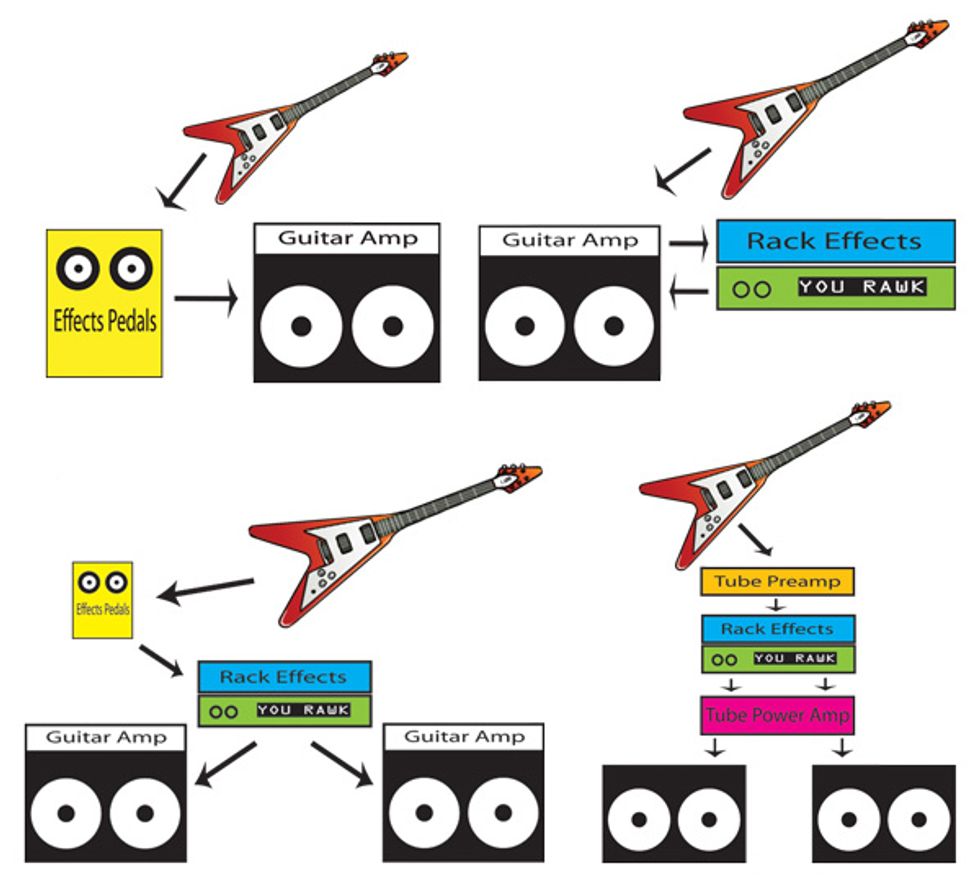Guitar amplifier effects loops are quite a controversial topic with tone purists. Common questions go from, Do I run my effects into the front so as not to disturb the amp’s tone? and Do I use the effects loop to get better delay sounds? to the even more drastic, Do I install an effects loop on my vintage amp?

It’s just another aspect of your rig scene, and often comes down to personal preference. There are times when an effects loop comes in handy on a gig, and others when it can cause your tone to suffer, all depending on what you’re trying to get out of your amp.
In a typical guitar amplifier, there is the preamp stage and the power amp stage. The effects loop is almost always placed right between the two. The idea is that your preamp channel switches between clean and overdrive tones, feeds into your effects via the effects loop, then back into the power amp stage. Placing your effects after your preamp works very well if you’re generating all of your clean and distortion tones solely in the preamp stage.
On the other hand, effects loops don’t always work well if you’re generating your overdriven tones by cranking your amp to get overall distortion and compression from both the preamp and power tubes, as with vintage style, nonmaster volume and low powered amps. Inserting the effects between preamp and power stages in this case most often impedes their interaction, and leaves you scratching your head wondering why you have weird levels, funny buzzing from your effects, or general tone suck. The preamp may be sending out such a strong signal that it hits the effects too hard, requiring you to pull back the level (if you have control of the input gain), and then the power stage can’t react properly since it’s not getting hit hard enough.
Analog-digital-analog effects interrupt that preamp-power amp interaction, in which case you’re better off running your rack effects into the front—or getting elaborate with a nice, big eighties-style stage rig: the vintage head into a load box feeding into your effects rack, then into a stereo tube preamp with two 4x12s. Yeehaw! (But remember: never run your amp’s speaker output into your effects input, unless you want to blow it to smithereens.)
Here’s a handful of recommended scenarios:
1. Run your stompboxes into the front, not through an effects loop. They are designed and intended for this both tonally and levelwise, and will cause very little change to your amp’s tone and the power-amp distortion it generates. In fact, many pedals can improve your overall tone by their effect on your input impedance—buffer circuits are designed to allow longer cable runs without loss of signal. Plus, if you run your pedalboard thru an effects loop you’re creating unnecessary excess cable lengths, which can impede your tone or cause noise issues.
2. Run your rack effects into an effects loop. This scenario works best using an amp with preamp, master and channel switching for clean and dirty, with your distorted tones generated by the preamp stage. Delay mix levels generally remain even between clean and dirty. Most rack effects units have bypass footswitching ability, as well as MIDI, which really gives you flexibility using a MIDI foot controller (but be prepared to pull out your propeller hat).
3. Run all of your effects in the front; feed pedals and rack effects into two amps for stereo. This works well if you use a tubepreamp stompbox to generate your distortion and mainly use the amplifiers for overall tone and volume level. And you can swim in stereo heaven onstage.
4. Run a rack tube preamp into rack effects, into a stereo power amp (tube preferred), into a stereo speaker cabinet or two speaker cabinets for full-on stereo bliss. A lot of great sounds you’ve heard over the years have been created this way.
5. Forget all of your pedals and plug straight into the front of the amp. (No diagram needed!)
Well, it appears I could elaborate further, so perhaps I’ll do so in next month’s column. Until then, happy late night hours twiddlin’ with your tone… I’m right there with you.
Peter Stroud
Peter is co-founder of 65amps.
sherylcrow.com
65amps.com






![Rig Rundown: Russian Circles’ Mike Sullivan [2025]](https://www.premierguitar.com/media-library/youtube.jpg?id=62303631&width=1245&height=700&quality=70&coordinates=0%2C0%2C0%2C0)

















